Trollius albiflorus (syn. Trollius laxus ssp. albiflorus) is a common plant of wet alpine meadows, blooming shortly after the snow recedes. I find that the white ticking at the leaf-section junctions makes the plant readily identifiable amongst the other meadow foliage, after the bloom season.
http://www.efloras.org/florataxon.aspx?
Odd that e-Flora of North America claims it occurs in more-or-less acidic substrates, while it is also a common plant here in the front ranges of the northern Rockies, where extremely thick sections of limestone and dolomite form vast outcrop exposures and alkaline substrates.
http://linnet.geog.ubc.ca/Atlas/Atlas.aspx?sciname=Trollius%20albiflorus...
http://plants.usda.gov/java/nameSearch?keywordquery=trollius+albiflorus&...
http://www.swcoloradowildflowers.com/white%20enlarged%20photo%20pages/tr...


Comments
Trond Hoy
Re: Trollius albiflorus
Sat, 12/17/2011 - 11:14amYou don't call this a globeflower, do you ;)
It is a nice plant and I intend to plant some at my cabin in the mountains :o
Lori S. (not verified)
Re: Trollius albiflorus
Sat, 12/17/2011 - 11:33amAs I'm sure you realize, Trond, globeflower is a common name for the genus.
Trond Hoy
Re: Trollius albiflorus
Sat, 12/17/2011 - 11:39amYes, I know, but does this species have a common name?
Lori S. (not verified)
Re: Trollius albiflorus
Sat, 12/17/2011 - 11:45am"Globe-flower" - as there are no others to confuse it with here, this is generally sufficient - or "white globe-flower", as indicated in the links I posted.
Trond Hoy
Re: Trollius albiflorus
Sun, 12/18/2011 - 7:53amOK, I hoped it had a special name, as "globe"flower isn't very descriptive ;)
The one found here is called "ballblom" (=ballflower) and is the common Trollius europaeus.
A picture from this site:
http://www.rolv.no/bilder/galleri/fjellplanter/trol_eur.htm
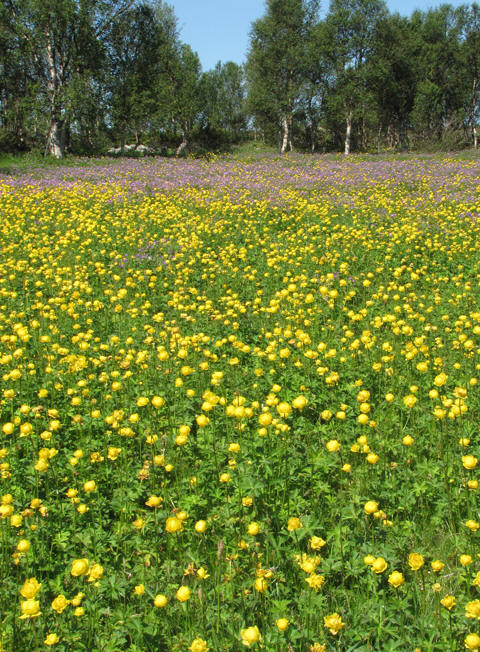
Panayoti Kelaidis
Re: Trollius albiflorus
Thu, 12/22/2011 - 6:53pmLori! I am ASTONISHED at how white your Trollius albiflorus is! The plant must have been named for one like your's: here in the southern Rockies they are a tepid, lemonade color. Nothing to write home about. And they are IMPOSSIBLE to grow for us...
But their eastern cousin (which is endangered in many states) is a great garden plant. The picture below is of Trollius laxus v. laxus in the Rock Alpine Garden at DBG this past spring. The color is just a tad yellower than our local "tepidflorus" form.
Thanks!
Trond Hoy
Re: Trollius albiflorus
Fri, 12/23/2011 - 7:55amWell, I like both forms! Even the one with "tepid, lemonade color". Wouldn't mind growing any of them!
maggiepie (not verified)
Re: Trollius albiflorus
Fri, 12/23/2011 - 12:30pmI like them all too.
Had no idea you could get such small forms. :-[
Lori S. (not verified)
Re: Trollius albiflorus
Fri, 12/23/2011 - 4:01pmInteresting that there would be significant difference in the flower colour of T. albiflorus in the more southerly populations. I haven't tried it in the garden, but should collect a little seed some time and give it a try.
Here is what I have as Trollius laxus, not near so yellow as the one you show either. It's a really good garden plant here too, even in our relatively dry climate (though maybe not so different from yours re. precipitation(?), though it certainly gets a lot hotter there, Panayoti).
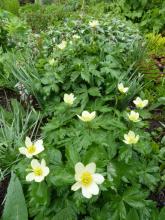

Richard T. Rodich
Re: Trollius albiflorus
Sat, 12/24/2011 - 12:17amI never really thought about this before, until I notice how much Lori's photo of Trollius laxus looks like an anemone (at least to me):
Is there an easy way to differentiate between the two genera?
Lori S. (not verified)
Re: Trollius albiflorus
Sat, 12/24/2011 - 8:29amHere's a photo from the Alplains site of T. albiflorus. Is this more how those in your area look, Panayoti, as compared to the chalk-white flowers that occur here?
http://www.alplains.com/images/TrolliusAlbi.jpg
Good question, Rick. I had recently googled one or the other of these species and was mentally questioning the ID of one of the photos that came up, re. native North American Trollius versus Anemone.
This key to Ranunculacaea at eFlora of North America is a lot more complicated than I can wrap my little mind around right now (although the answer is in there, of course):
http://www.efloras.org/florataxon.aspx?flora_id=1&taxon_id=10757
Hmmm, a good little research project... unless some knowledgeable person out there can help us out by explaining in simpler terms? Pretty please? :)
Richard T. Rodich
Re: Trollius albiflorus
Sat, 12/24/2011 - 9:51amYes, if I could only tell if the fruit was an achene or utricle, as opposed to something else :rolleyes:
Yow! (and Help!)
Lori S. (not verified)
Re: Trollius albiflorus
Sat, 12/24/2011 - 10:25amOooh, oooh, I know that one!! (Or rather to be honest, I didn't, until I thought for a while about what the seed structures look like for these genera and then looked up the terms! ;D)
Here are the
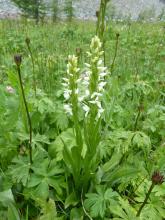
"utricles"* (correction: "follicles", see following posts) of Trollius albiflorus in the background of this photo:And here are the "achenes"** of Anemone lithophila:

*Utricle: "A small, thin-walled, one-seeded, more or less bladdery-inflated fruit.
**Achene: "A small, dry, indehiscent fruit with a single locule and a single seed (ovule), and with the seed attached to the ovary wall at a single point, as in the sunflower".
Both definitions are from Harris and Harris' Plant Identification Terminology: An Illustrated Glossary
But of course that only helps us when the seed structures are visible. What about the rest of the time?
Mark McDonough
Re: Trollius albiflorus
Sat, 12/24/2011 - 11:12amI've gone through the Flora of North America key several times, and from what I can tell, only Trautvetteria has utricles (yes, I had to look up these terms too :)), and only rarely do utricles occur in Ranunculus (typically has achenes). Going through the "couplets" in the key, couplet #4 branches off to get to Trollius at #12: fruits are follicles, capsules, or berries, and to get to Anemone follows #5: fruits are achenes or utricles. So I don't think Trollius has utricles, it has follicles (aggregated follicles), and Anemone has achenes (aggregated). Seems that fruit structure is most definitely an important part of genus differentiation in the Ranunculus family.
Lori S. (not verified)
Re: Trollius albiflorus
Sat, 12/24/2011 - 11:38amAhh, thanks, Mark, for having the mental horsepower to actually work through the key!
In my opinon, the key pulled a bit of a fast one on us in going from:
"Flowers radially symmetric; sepals showy or not; petals present or absent, smaller to larger than sepals. (4)"
To:
"4 (1) Fruits achenes or utricles; ovule 1 per pistil. (5)"
To (skipping a few steps in between):
"Achenes without veins on lateral surfaces; style present. 5 Anemone"
... without following up on the utricle/achene/etc. differentiation.
However, by looking in the descriptions of the individual genera, the differences are explained, as you have pointed out, Mark. (Lesson learned... one must grind through the whole key and the individual descriptions sometimes!)
So, the definition of "follicle": "A dry, dehiscent fruit composed of a single carpel and opening along a single side, as a milkweed pod" (Harris & Harris).
Scroll down in this link to see seed structures ("utricles") of Trautvetteria caroliniensis:
http://www.missouriplants.com/Whitealt/Trautvetteria_caroliniensis_page....
So, anyway, I think it's safe to say that the seed structures of Anemone and Trollius look different... not to put too fine a point on it. ;D ;D
Richard T. Rodich
Re: Trollius albiflorus
Sat, 12/24/2011 - 11:53amExactly, Mark.
Of course each achene or utricle is an individual one-seeded part of the seed head. I (we) am very familiar with an achene on a Thalictrum sp., but I am not prepared to translate that into other genera. (I have that book you mention too, Lori, and it says a sunflower seed -with the shell - is an achene,also.) And in addition, I have no idea what other botanical structures might look like them.
Differentiating between Trollus and Anemone, I suppose you could say with certainty that if the individual structure (not the aggregate head) has more than one seed, than it cannot be an anemone. But I wouldn't necessarily say the other way around is true.
While at a Chapter get together for seed packaging this year, I discovered we now have a British member who is trained in plant taxonomy, and often used a dissecting microscope for her work. I should pick her brain... a lot!
Anonymous (not verified)
Re: Trollius albiflorus
Sat, 12/24/2011 - 3:35pmHi Lori, The answer to you question is rather complicated. Organic material decomposing over limestone is typically sub-acidic. Acidic areas might be found locally on rotten stumps, logs, and such. The habitat of Trollius laxus is organic material that has formed over limestone. I understand this species is typically located in Thuja swamps.
The controlling factor in water pH levels is predominantly the amount of Carbon dioxide gas that is dissolved. Oxidizing organic material produces acids which change to dissolved Carbon dioxide (an acid) upon complete decomposition. When ground water reaches the surface the dissolved Carbon dioxide can be released as a gas. This rapid increase in pH causes the precipitation of minerals like Calcium carbonate. This is the mechanism that forms tufa.
Temperature is also an important factor. As the temperature rises less Carbon dioxide is soluble in water. This can increase the pH of the soil further. Only the most tolerant plants can withstand a high pH level. This is one reason many native species will no longer grow in old field which have lost most organic matter. It may take many centuries for the organic matter to rebuild to the point that the ecosystem can recover.
The follicle/achene difference has always confused me.
James
Lori S. (not verified)
Re: Trollius albiflorus
Sun, 12/25/2011 - 10:48amThanks for a review of the chemistry, James.
I have no problem accepting that the organic layer layer that forms over alpine bedrock may form a widespread acidic layer in the southerly range of T. albiflorus, where the bedrock itself is primarily acidic in nature (being largely composed of igneous and metamorphic rocks - much different geology than here where the alpine exposures are largely very thick successions of limestone and dolomite that were thrust-faulted to surface), and also that deep-rooted alpine plants there may only have their roots coming into contact with acidic groundwaters. (N.B. By the way, neither T. laxus nor Thuja swamps occur here.)
I find it hard to believe here, though, that the acidic effect from the thin organic layer that forms over calcareous bedrock would not be not rapidly counteracted by the flow of CaC03-laden waters through and across hundred of kilometers of carbonate outcrops, and that the deeply penetrating roots of many of these alpines would not be contacting alkaline groundwater. Note that I am talking about alpine areas here, where glacial action has scoured the surfaces clean, and there is no layer of Precambrian shield-derived glacial drift (such as we have out on the plains here, and as you also have in your area). Where moraines were deposited, they consist of screes and talus of largely carbonate material.
These high elevation areas are, of course, groundwater recharge areas, but the groundwater flow is not only vertical downwards (from rain and snow melt) but also lateral across and through the near-subsurface of vast expanses of carbonate rock. (While groundwater recharge occurs on a particle scale, note that these formations have relatively high porosity and permeability, enough to act as economically-producible hydrocarbon reservoirs in this area.) Groundwaters in the front range Rockies are calcium-magnesium-bicarbonate type waters, and the main effect in areas where the waters flow through less-calcareous area (e.g. alluvial fans from Cretaceous deposits) is relatively minor (slightly lower TDS, for example).
Anyway, it's something I'll have to talk to our hydrogeologists at work about. And better yet... I think I'll arm myself with some pH tabs and use them this coming summer to see if I can finally satisfy myself on this once and for all!
Trond Hoy
Re: Trollius albiflorus
Sun, 12/25/2011 - 12:27pmAchenes (and utricles) never open and release their content. All Trollius I know of have follicles that open and release black seed. I would say that the difference between the genera Anemones and Ranunculus is more difficult as both have achenes. However, Trollius and Ranunculus do have nectaries which Anemone doesn't have.
Take a look here:
http://www.google.no/url?sa=t&rct=j&q=eudicottene&source=web&cd=2&ved=0C...
http://www.google.no/url?sa=t&rct=j&q=eudicottene&source=web&cd=1&ved=0C...
Regarding acidic soil: A plant can grow in a thin layer of acidic peat overlying basic bedrock and the peat can stay acidic as long as the precipitation is greater than the evaporation. It doesn't matter that the roots grow down into the basic underground as long as some of the roots can take up the ions needed from the acidic peat. Acidic or basic - it is a question of solubility of ions. All plants need approximately the same ions in the same proportions. However, the ability to ion uptake from soils of different acidity differs greatly.
Anonymous (not verified)
Re: Trollius albiflorus
Sun, 12/25/2011 - 1:34pmLori,
Silica based rock is not acidic. Most Silica based rock is not involved in the water chemistry. This type of rock is like a glass beaker. It holds the reaction, but does not effect it. This is the reason the oxidizing organic material makes water so acidic (~pH 4, about the acidity of an apple). In this situation, the rock does not dissolve. In a Calcium carbonate system Carbon dioxide can be released as a gas which buffers the solution.
Although my area does have Precambrian shield-derived glacial drift, it has been deposited on the Niagara escarpment. The only really acidic habitats are where sand deposits have been leached of ions and oligotrophic bogs as described by Hoy.
Limestone deposits are often quite hard. My observation is that water typically moves laterally over them, instead of through them. The exceptions are where a fault in the layer occurs or a cave has been dissolved through the stone. I am curious about your statement that "groundwater recharge occurs on a particle scale?" I will have to research this topic more.
How have you come to know so much about geology?
James
Lori S. (not verified)
Re: Trollius albiflorus
Sun, 12/25/2011 - 1:36pmI'm not sure how or whether this point considers the lateral groundwater flow that I mentioned. (There is very little flat ground in the mountains, a very thin layer of organic materials, and a vast amount of carbonate material for water to flow through and across.)
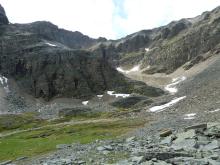
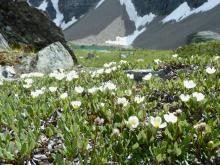
Here is the sort of thing I am wondering about. Should the tiny lake in the second photo, a couple of hundred meters downslope from the limestone cliffs and moraines in the first photo, have an acidic pH, given the areas of thin turfy substrate between it and the limestone exposures above?
Anyway, a basic point behind my bringing this all up is that even if a plant occurs where the substrate is acidic, it doesn't necessarily mean it requires acidic substrates. The important factor in alpine areas may be the actual presence of a soil that allows the plant to be able to grow where it does, not that the soil may be acidic. As James pointed out, T. laxus may occur in acidic substrates in nature but does nicely in alkaline soils here.
Trond Hoy
Re: Trollius albiflorus
Sun, 12/25/2011 - 1:52pmLori, you have to meassure the pH in the soil!
But, as you say, a plant doesn't necessarily require acidic substrate although it grows in it. However, it seems that some plants prefere higher pH or rather more mineral rich soil here in Norway than they do further south in Europe.
Lori S. (not verified)
Re: Trollius albiflorus
Sun, 12/25/2011 - 6:53pmSure, I'll take distilled water along... but if the plant is growing right next to surface water, I think I'll assume it's probably it's in contact with the same water.
James, you're right that silica is neutral in this sense but don't confuse "rocks" with the mineral, silica. Rocks are rarely composed of only SiO2. For example, even an extremely clean sandstone (100% quartz grains) may be cemented with calcite, and flow through it would contribute to making groundwater alkaline and hard. (And silica is soluble although that's not an overly important point here.) The basic groundwater cycle is that recharge occurs on topographic highs, seeps down through surface deposits and continues down through bedrock as long as permeability and the pressure gradient allow it to do so. At the same time, water is also moving laterally downslope along the near-subsurface, also laterally in the subsurface along whatever permeabilty trends exist, and in the direction of decreasing pressure. Note that the permeability (connected porosity) through these strata can be extremely low; even thick shales, and even those considered to be aquitards, can still allow fluid movement through them - this is occurring on a particle or even molecular scale (water molecules moving through minute pore throats between grains and crystals, or even replacing water molecules bound up in the crystal matrix), not at a rate that is necessarily "observable" by humans or even necessarily in the timeframe of a human lifespan (though it can be measured and calculated by various means). The composition of the bedrock and soil has everything to do with the resulting chemistry of groundwater, as groundwater picks up dissolved minerals from its flow through these materials.
Limestone (rock composed of the mineral, calcite) is actually quite soft in rock terms, but the hardness of a particular mineral has little to do with the porosity and permeability that may exist in rocks composed of that mineral or more commonly of a mix of various minerals. Almost all rocks have some at least minute measurements of porosity - and permeability - thus allowing fluid flow through them (as above, in the groundwater cycle discussion). Economically-exploitable hydrocarbon reservoirs, and aquifers, are examples where strata in the subsurface have high enough porosity and permeability that fluids (gas, oil or water) that fill the pore space (or fracture networks, sometimes) can be pumped out at significant rates. (In other words, it's not coming out of underground lakes or caves, as people sometimes imagine.)
Anonymous (not verified)
Re: Trollius albiflorus
Sun, 12/25/2011 - 11:59pmLori,
You never answered my question.
Yes, I should have been more specific and said Silicate ceramics.
The reason I mentioned hardness is because limestone survives erosion better than many other sedimentary rocks. This maintains the integrity of the barrier effectively restricting the vertical movement of ground water flow.
James
Lori S. (not verified)
Re: Trollius albiflorus
Mon, 12/26/2011 - 9:09amI'm a geologist, James. My most recent role was providing management and geology support to a hydrogeology group within our company - very interesting work.
I guess it's only fair that I ask what you do, James?
No, begging to differ... On the point of "hardness", you seem to be discounting quartzose sedimentary rocks for some reason. But again, the point isn't the hardness of rocks or their resistance to erosion - it's the porosity and permeability within them. Your observation that water appears to run over a particular limestone is made from the point of view of what you can actually see... we don't have the ability visually to even see the porosity network in most rocks without magnification (and without measurements that may be quite oblique in some cases). And you're referring to a particular limestone... due to depositional and burial processes, the same limestone strata may have much different (higher or lower) porosity and permeabilty in another locale. I assure you that there are limestones (and dolomites, moreso) that soak up water like a sponge too... although fluid flow doesn't depend on high levels of porosity and perm. Anyway, it's all a matter of scale... both of time and of physical properties.
Back to the basic question, it may also be the water in the alpine zone has not been in contact long enough with the substrate to be altered as much as I'm assuming? As I mentioned, groundwater picks up dissolved solids by passage through rocks and soil; the longer the transport, normally the higher the total dissolved solids, hence the alkaline groundwater coming out of springs in the mountains, flowing in the rivers that come out of the mountains, and out here on the plains. Well, some simple testing may solve it for me, as I said.
Anonymous (not verified)
Re: Trollius albiflorus
Mon, 12/26/2011 - 10:57amNothing much of use. I just like to grow plants. I thought this topic must be your expertise. I had to think really hard to understand your posts.
Of course limestone can be porous, for example tufa. Of course there are harder stones that resist erosion even better. When I am talking about a hard low permeability limestone (actually dolomite in this case) I am relating to a geological feature in my area. The Niagara escarpment dolomite does cause water to move laterally. The best example I can think of is Niagara Falls. Water moves laterally over the Niagara escarpment dolomite until the Falls. Erosion is only significant in the plunge pool where the large energy release has carved the gorge back a number of miles.
Maybe so, but we can still see the results in areas with vertical cliffs. We can see water seeping right out of a cliff face.
If you really want a challenge ... try to figure out the reason Sarracenia purpurea (which normally grows in acidic bogs) is also able to grow in extremely alkaline habitats. Mr. Todd Boland posted a excellent picture in the following thread.
http://nargs.org/smf/index.php?topic=392.msg3838#msg3838
James
Trond Hoy
Re: Trollius albiflorus
Mon, 12/26/2011 - 12:03pmAn easy way to get an idea of how much water seemingly solid rock can contain is to weight it!
Submerge a stone for a while, the let the surface dry and weight it. Then let it dry for a while in an oven (not too hot) and weight it again. Maybe not very scientific but you'll get an idea of how much water different rock types can contain.
cohan (not verified)
Re: Trollius albiflorus
Wed, 01/11/2012 - 12:13amInteresting topic, both plant-wise and geologically :)
There has been a lot of discussion of soil and water acidity/alkalinity in cactus growing circles, and while I wont try to give the whole discussion, there are a couple of interesting points that I'll try to give my paraphrasing of- any inconsistencies are likely mine rather than those who have thought about this a lot...lol (which relate to very different plants and environments than what we are talking about here)-- while many cacti come from areas with alkaline soils, it has been found in recent years that they respond very well to slightly acidified watering (people started by adding vinegar, and it has got more sophisticated) to compensate for alkaline well water and city water (rain water presumably does not need it).. the thinking being that of course rain water in nature is not alkaline, and apparently rain in electrical storms is particularly acidic, and some dry areas receive much of their precipitation in thunderstorms.. in any case, those adopting the acidified watering strategy for potted cacti have generally had remarkable improvements in health, growth, flowering and even insect resistance...
Re- Trollius vs Anemone etc-- achene is a fruit type that crops up in all sorts of plants.... Is it just my imagining (wasn't sure from the pic) or does the Trollius seedhead not look a lot like Caltha? The Anemone seedhead looks like many other fuzzy head spp. A canadensis has a very different seed head-- without looking up the proper terms- just sort of a ball of seeds stuck together till they ripen and fall apart... no fuzz, and no chambers holding them...
I love the Alplains Trollius! Lori's pure white is lovely, but I'd read Alplain's description in the paper catalogue and hadn't got around to looking up the image, it is as nice as I thought it sounded-- creamy yellows are my favourite yellows...